Clifton Bieundurry
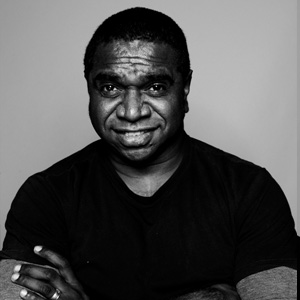
The key indigenous artist for Nomad Two Worlds, Clifton Bieundurry, is a multi-talented Walmajarri artist from the Central Kimberley region. His formative years were spent immersed in traditional language and cultural practices in his family homeland. His indigenous paintings have become highly collectable. Renowned for his distinctive mix of acrylics and ochre on handmade paper, linen and canvas his striking contemporary representations of his ancestral country tell stories of social justice issues confronting his people. Widely acclaimed for his solo art exhibitions in New York (2007), Los Angeles (2007) and at The Art of Australia Gallery in Melbourne (2008) he is also the two time winner of the prestigious Shinju Art Award in Broome (2005-2006). The featured artist of Old Broome Lockup Gallery since 2005 Bieundurry also plays a pivotal role as a cultural interpreter assisting Kimberley Aboriginal people in community development projects. “I feel there is a gap in interpreting Aboriginal culture, the contemporary and the ancient, to the outside world. I paint to fill that gap so that translation is clear and understood; not only by non-Indigenous people but also by Indigenous people themselves,” Bieundurry says.

Innocence Ngapa Pirlirr
Translation: Innocence Water Spirit
This piece is a reproduced as an N2W only. The work is based on the original work titled Innocence Triptych which contained 3 individual panels each 5’ x 12’ archival pigment ink printed on rag cotton with acrylic and ochre applications. The N2W, Innocence Ngapa Pirlirr, measures 48”x60”.
James’ photograph represents the period of Innocence, when indigenous culture was at the height of its peaceful reign.
Bieundurry’s collaborative art is inspired by pirlirr, an expression of spirit that comes from land, culture and family. The connection of Aboriginal people to ‘country’ is integral to the continuity of cultural beliefs and practices. In his traditional country every living and non-living thing has a spirit and when several spirits join they can form a pirlirr (soul). Pirlirr roam the country for decades in search of the parents of an unborn child who will carry it. Upon finding the right parents it transfers itself into a totem (jarriny), which comes in the form of an animal. While in the totem it will guide this animal into the path of the parents.
The animal is hunted and eaten for food by the people its related to and the pirlirr is guided into the path of the parent. After the pirlirr has passed on the spirit disperses back into the earth from where it came.
The collaborative art piece represents the birth of a spirit/soul or pirlirr.
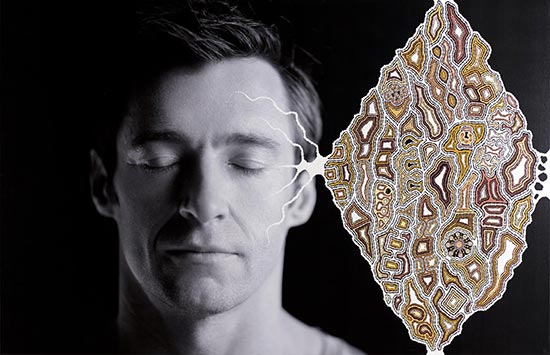
Australian Roots
Photograph by Russell James. Collaborative art by Clifton Biendurry (AU).
4'6" x 7' archival inkjet on canvas with acrylic applications.
This painting is called "Australian Roots" because it is a reminder of what connects us to our home, that the Earth will draw us back and guide us. There are symbols within this painting that represent family and their roles within the family including nurturer, provider and protector.
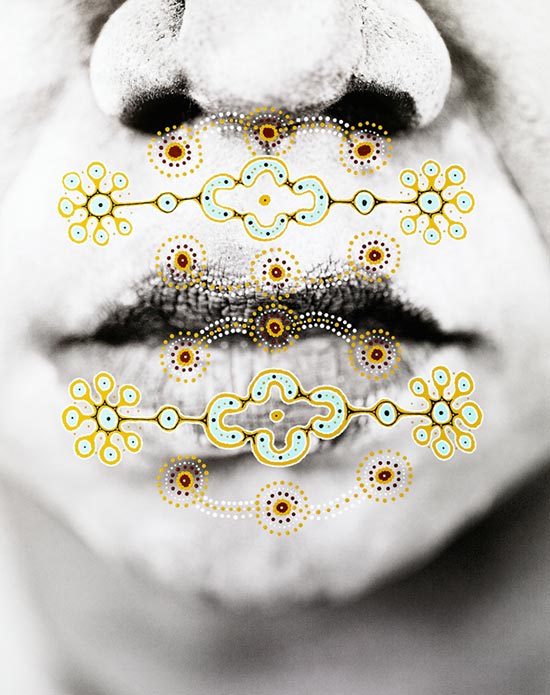
Discovery Kuruwarri
Translation: Essence of self, the DNA of the soul.
Photograph by Russell James. Collaborative art by Clifton Bieundurry (AUS).
James' photograph of Bieundurry's face painted in traditional ochre represents James' desire to understand the ancient culture of Indigenous Australians.
Bieundurry's collaborative art represents the essence of Walmajarri people and their bloodlines and beliefs - physically and spiritually - ingrained in their art and ways of being, and passed down to generations as artistic expression. Bieundurry learned from his father, uncles and brothers and pledges to continue by passing this cultural knowledge to his own son.
Ngajimana minyarti nguwajanka. Minyarti nguwapa ngaji. Pirlajartipa ngaji. Ngajipaju pirlirr manyanjadu minyarti nguwanga. (Translation: I am of this earth. The earth is of me. My flesh will perish. But in the earth my soul will rest.)
The combined art piece represents the transference of cultural knowledge.
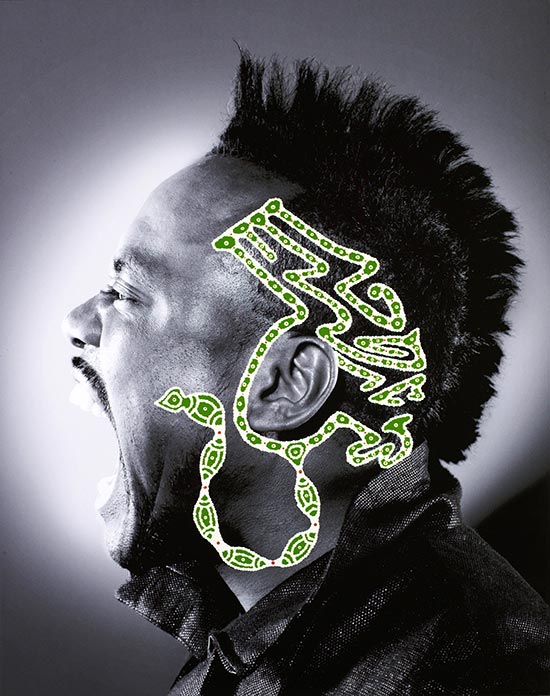
Apl de Ap Kalpurtu
Translation: Creation Serpent
Photograph by Russell James. Collaborative art by Clifton Bieundurry (AUS).
The serpent is symbolic as it is the great being who created the Earth during the Dreaming (creation). It was an immense creature who traveled the land forming hills, lakes, creeks, mountains, gorges and desert springs. This serpent rests in the earth, and must be respected and acknowledged by each generation. Just as the creative and spiritual mind of physical beings must be respected, nourished and acknowledged.
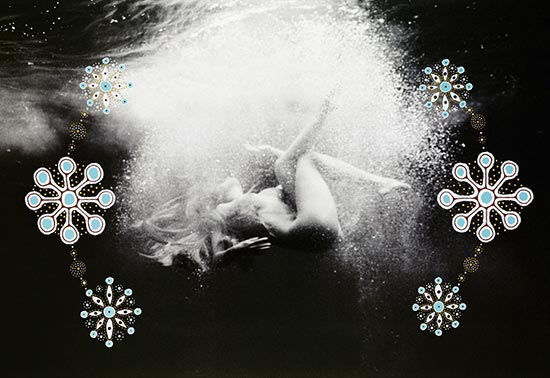
Innocence Pirlirr
Translation: The Soul
Photograph by Russell James. Collaborative art by Clifton Bieundurry (AUS).
James' photograph represents his vision of 'Innocence', a perfect time in indigenous culture without external influence. However, 'Innocence' can be seen closer to the surface and unbeknownst to her, change was imminent.
Bieundurry's collaborative art represents the birth of a spirit at its purest. This spirit exists in culture and the lore of all the land and waters and its creatures. This particular incarnation of pirlirr inhabits 'Innocence'.
The art piece represents a perfect moment in ancient history that prevailed for tens of thousands of years, naive to any signs of approaching change.
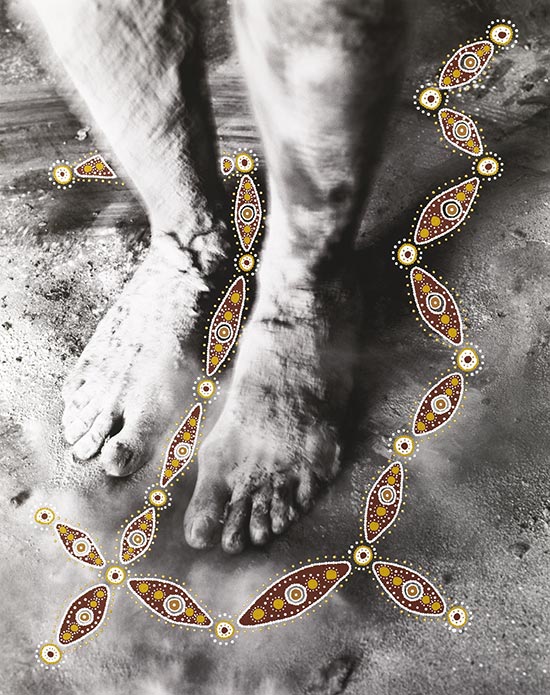
Discovery Jinapungu
Translation: Tracking of the journey.
Photograph by Russell James. Collaborative art by Clifton Bieundurry (AUS).
James' photograph of the feet represents the journey taken by modern civilization as it trampled the country that was so significant to the indigenous culture.
The collaborative art by Bieundurry represents the path indigenous people have taken through gathering information and gaining knowledge over time. The intersections represent significant decisions in the cultural past that have influenced cultural knowledge and identity. For Walmajarri people, there have been important decisions made at various times in their very long history, in this way strengthening and maintaining culture.
The combined art piece represents the journey of both cultures that have lead us to where we are today.
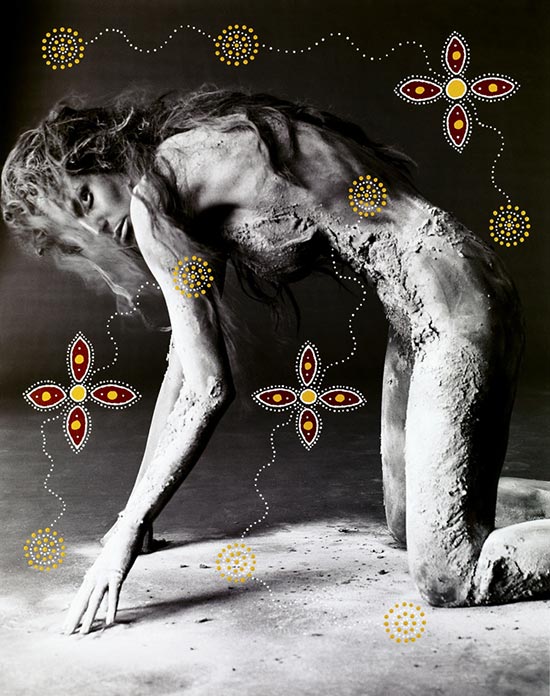
Discovery Walmajarri
Translation: The people of a specific area in The Kimberly Region.
Photograph by Russell James. Collaborative art by Clifton Bieundurry (AUS).
James' photograph represents 'Discovery', a character that he imagined to represent the new powerful entity we could become by combining the best of both cultures signifying the end of the time of conflict and the birth of a new unified time in our future.
The collaborative art represents the central fireplaces used as meeting areas for members of the Walmajarri tribe. Tribes gather around the fire to share food, tell stories and share traditions with the younger family members and to learn about the land. The energy of the fire gives strength and purpose to culture. Fire also represents the new growth the land has after it has been burned, bringing a time of renewal.
The combined image represents what may emerge from mutual respect and renewal of tradition.
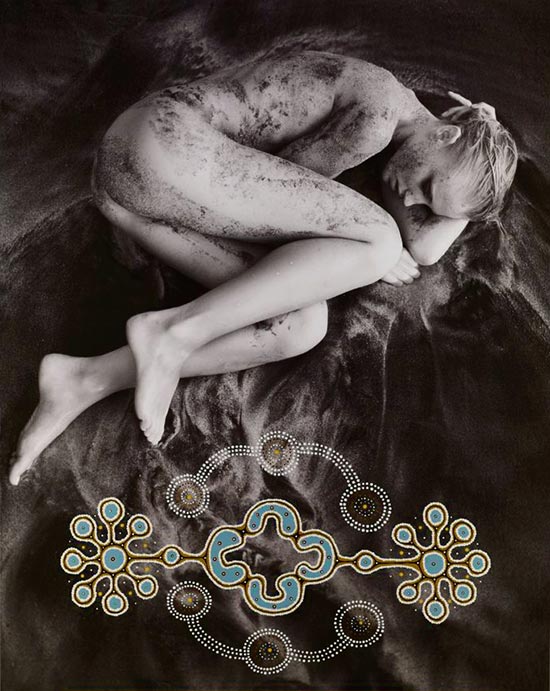
Innocence Rirringki
Translation: Water Edge/River Bank
Photograph by Russell James. Collaborative art by Clifton Bieundurry (AUS).
James' photograph of his imagined character 'Innocence' represents the near death of the planet's oldest surviving culture, collectively known as Australian Indigenous culture. The impact of modern civilization in the near extinction of this culture is now part of the Australian collective conscience and the motivation for reconciliation.
Bieundurry's collaborative art represent the spirit/soul or pirlirr, the introduction to the human shell in which it has chosen to dwell and ready for the conflicts it is to face from the choice. Pirlirr travel the earth in search of an appropriate form, human and non-human.
The combined art piece represents the end of innocence and the willingness of the indigenous culture to accept the new world in its stride.
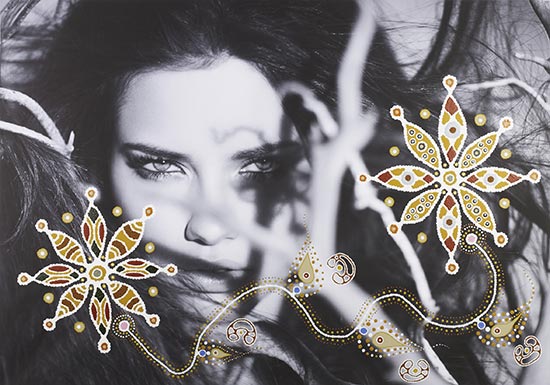
Inhibition Marninkura Pirlirr
Translation: Spirit of a woman.
Photograph by Russell James. Collaborative art by Clifton Bieundurry (AUS).
4’10” x 7’ archival inkjet on canvas with acrylic and ochre applications.
Pirlirr is an expression of spirit that comes from land, culture and family. The connection of Aboriginal people to ‘country’ is integral to the continuity of cultural beliefs and practices. Pirlirr underpins the importance of family in how the spirit of Aboriginal culture is maintained and how the spirit of an individual is shaped.
In my traditional lands every living and nonliving thing has a spirit (in the painting these are represented by the outer tips of the large design) , when elements of all these spirits come together they form a pirlirr (human soul) (the central point of each ‘star’).
This pirlirr will roam the land, sometimes for years or even decades, in search of the parents of an unborn child who will carry this pirlirr. When the pirlirr finds the right parents it transfers itself into a totem (jarriny), which comes in the form of an animal and while in the totem it will guide this animal into path of the parent/s.
For traditional people with whom the totem makes contact, the animal is hunted and eaten for food; but for non- Indigenous people the pirlirr will guide the jarriny in the path of the parents and makes itself known that it has found the Mother/Father of carrier of this pirlirr. The totem is transferred into the spirit of the unborn child. After the carrier human has passed on the spirit disperses back into the earth from where it came, and the process begins all over again.
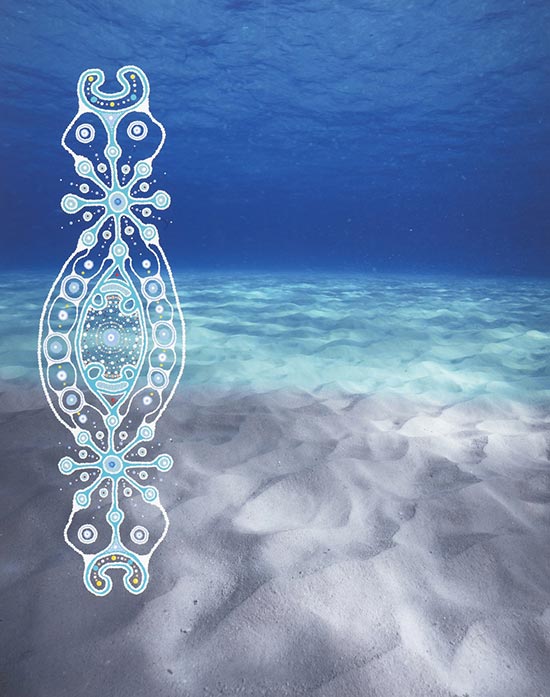
Becoming Jangala
Photograph by Russell James. Collaborative art by Clifton Bieundurry (AUS).
4’10” x 6’4” archival inkjet on canvas with acrylic and ochre applications.
There was once a great spirit that rested in the oceans, rivers and lakes. It flowed with the tides and currents of the earth’s water and showed its powers of creation and destruction.
The water spirit was balanced by its twin spirit in the Earth. Together they form the essence of the path which we can follow on a journey towards becoming greater than what we are.
This painting represents one such journey of a human who has accepted the challenge of discovering his own spirit. He has allowed himself to be guided by the spirits of our elders; surrendering himself to the cultural experiences and ancient wisdom of Indigenous people who have passed on knowledge of balance and respect for earth and water’s gifts.
This self-discovery has opened the man’s spirit to becoming Jangala.
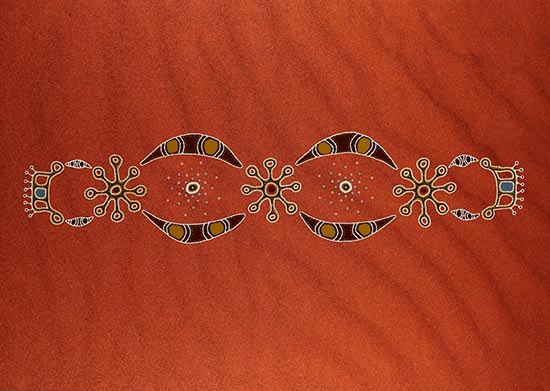
Inhibition Pindan
Translation: A fine, mineral rich red earth found in the Kimberly Region of Australia.
Photograph by Russell James. Collaborative art by Clifton Bieundurry (AUS).
5’ x 7’ archival pigment ink printed on rag cotton with acrylic and ochre applications.
James’ photograph was taken while accompanying Bieundurry to his ‘country’ by Lake Gregory in North Western Australia. The orange (pindan) is ever hot and shifting and forms a vast part of the land as a whole, while it plays a large role in Bieundurry’s family story.
In Aboriginal lore pindan represents the journey the indigenous soul or pirlirr takes in finding its homeland, carrying with it a hair belt which shows artefacts that identify it. The hair belt Bieundurry has painted indicates to other spirits (pirlirri) its origins and what lore it follows.
The art piece represents the conflicted values of a similar landscape and the soulful journey that is taking place.
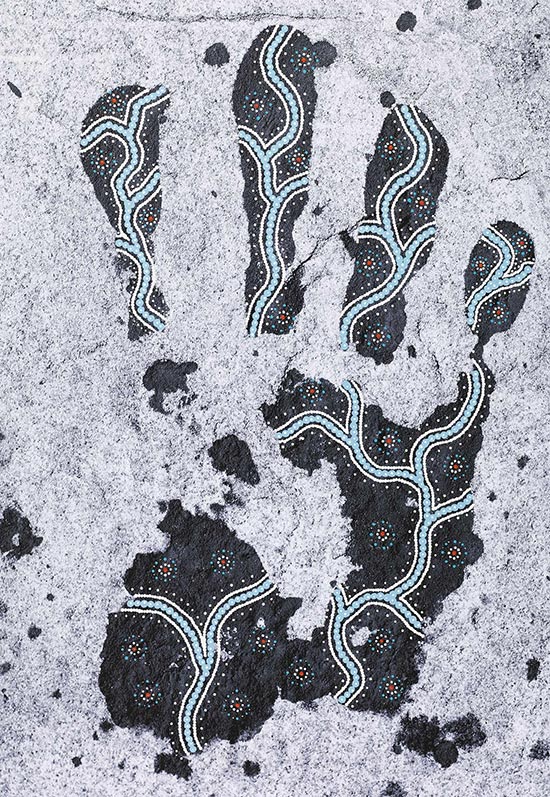
Innocence Kurrapa
Translation: Hand
Photograph by Russell James. Collaborative art by Clifton Bieundurry (AUS).
4’5” x 6’4” Archival inkjet on canvas with acrylic and ochre applications.
Walmajarri people believe that our human incarnation retains a deep and spiritual connection to the earth, because it was from the earth that our soul emerged. Human handprints are unique and have been recorded in Aboriginal rock art and designs for thousands of years. It is important to retain our connection to the earth and to feel its spirit to allow it to guide us on our human journey.
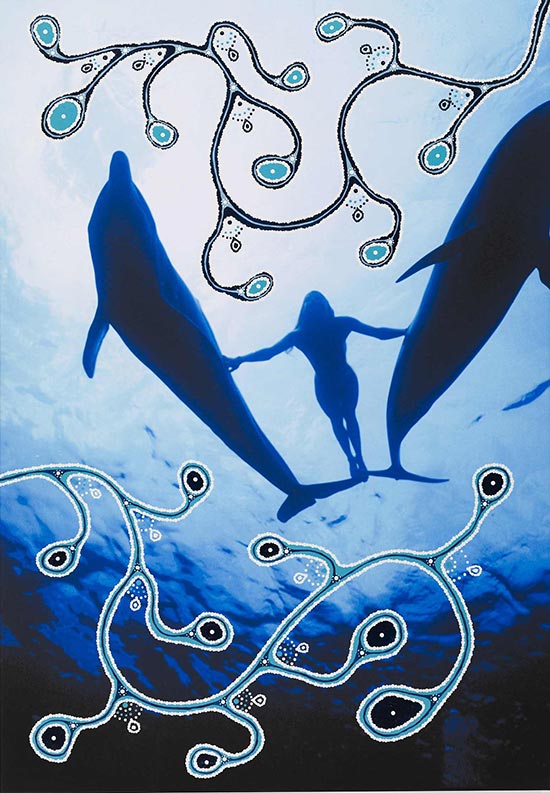
Innocence Ngapa Yuka
Translation: Water Grass
Photograph by Russell James. Collaborative art by Clifton Bieundurry (AUS).
4’5” x 6’4” Archival inkjet on canvas with acrylic and ochre applications.
The painting depicts the water grass that grows in natural lakes of the Great Sandy Desert. This grass would be used by Walmajarri men to catch water birds by placing the grass on their head then slowly the hunter would approach the water bird and catch them. The grass, when gathered in abundance, would make a good raft or floating device when crossing deep creeks. It is also known as the beard of the great spiritual serpent that created the Earth and who now resides in sacred waterholes. Traditionally, the Walmajarri people announce their presence to the Water Spirit by throwing pebbles into the water and stating aloud their kin group and tribe before drinking or entering the water.
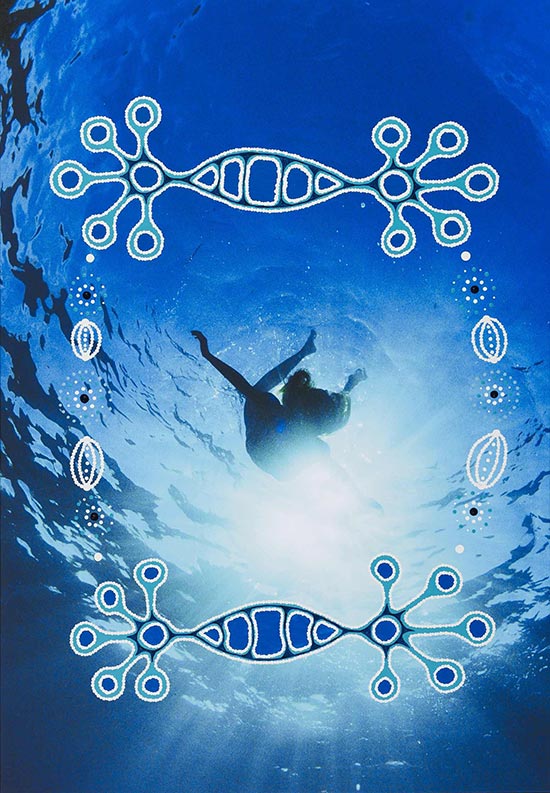
Innocence Wurrpturtangu
Translation: Rise Up / Grow
Photograph by Russell James. Collaborative art by Clifton Bieundurry (AUS).
4’5” x 6’4” Archival inkjet on canvas with acrylic and ochre applications.
This painting symbolizes the spiritual journey of a being as it transforms itself from soul to human form. The journey is physical as the human grows and changes with the passing of time, as well as spiritual as the experiences and cultural stories shape the personal and community journey.
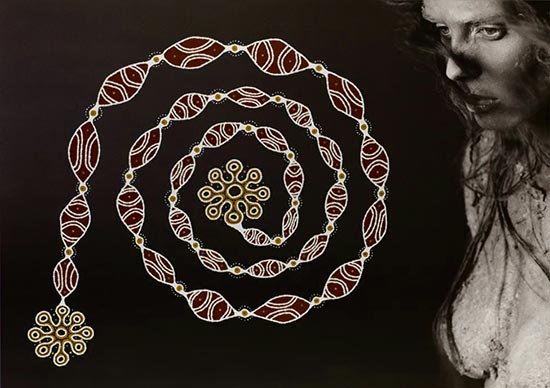
Discovery Pirlirr Muupungu
Translation: Spirit Search
Photograph by Russell James. Collaborative art by Clifton Bieundurry (AUS).
James' photograph represents a character he imagined called 'Discovery', a powerful new being who emerges from the conflicted time of 'Inhibition'.
The spiral represents the journey of the pirlirr. The pirlirr often wander the earth searching for a chosen human with whom it becomes compatible. During the journey pirlirr may take the temporary form of an animal before it enters the human it bonds with. The animals that precede the human entity become the totem or jarriny (animal brother or sister of the human) and holds significance in the way the human interacts with that animal in the natural environment.
The art piece represents the desire for self-realization and of how identity is a complex and fluid idea, but also that this is linked to group identity in the unification of different people across cultures.
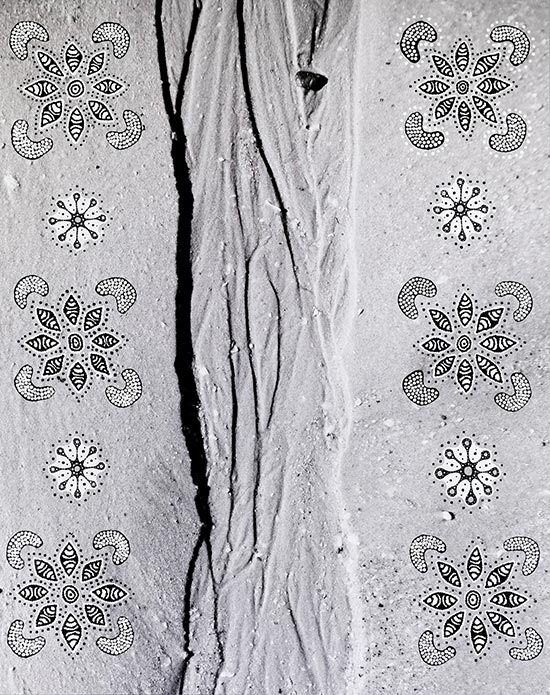
Innocence Maparn
Translation: Wise Power
5’ x 6.25’ archival pigment ink printed on rag cotton with acrylic and ochre applications.
James’ photograph represents the tracks of the eternal rise and fall of the tide: perpetually in motion and fleeting in its form, but permanent in its rhythm and continuous since the beginning of time.
Bieundurry’s collaborative art represents the birth of the human soul or pirlirr, and spiritual guidance. The smaller impressions represent the human soul left to its own fate to find its human shell. The larger markers represent the guardians of the human soul that guard and shepherd others. Bieundurry was inspired by the daily tidal finding of the path by the water, like the pirlirr must find their way.
The art piece represents an overall image of rhythmic perfection and the continuity of life.
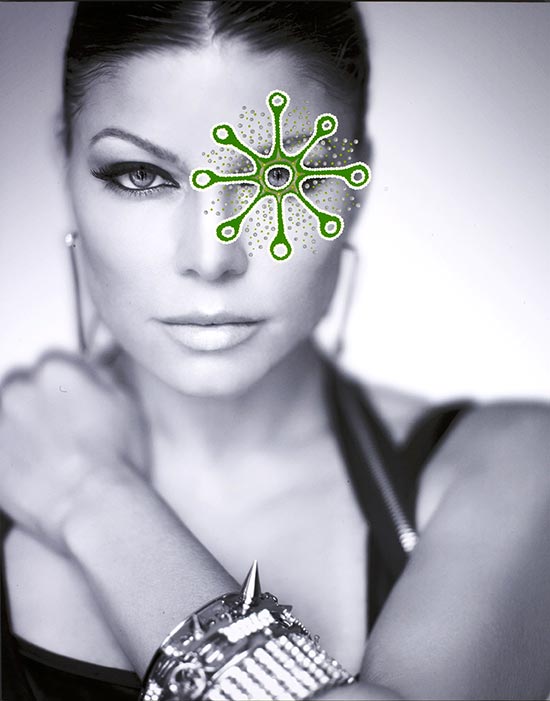
Fergie Nguwa Pirlirr
Translation: Earth's Spirit
Photograph by Russell James. Collaborative art by Clifton Bieundurry (AUS).
This painting represents the birth of a human soul (pirlirr). The markings surrounding the pirlirr symbol are the spirits of the earth gathering for rebirth to the human soul.
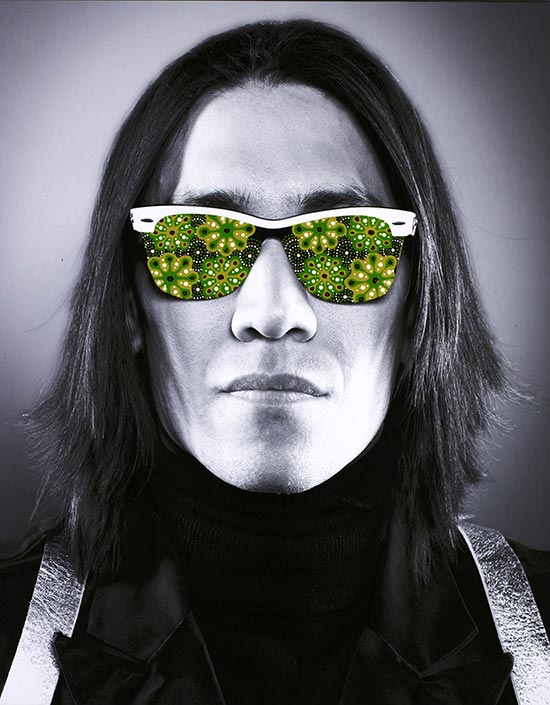
Taboo Mirljangka Pirlirr
Translation: Eyes of the Soul
Photograph by Russell James. Collaborative art by Clifton Bieundurry (AUS).
The symbols in the art represent the pirlirr or soul at its purest without human affliction. My tribe defines their sense of self and worth by the depth of understanding and respect for culture and lore. This knowledge is carried in the pirlirr.